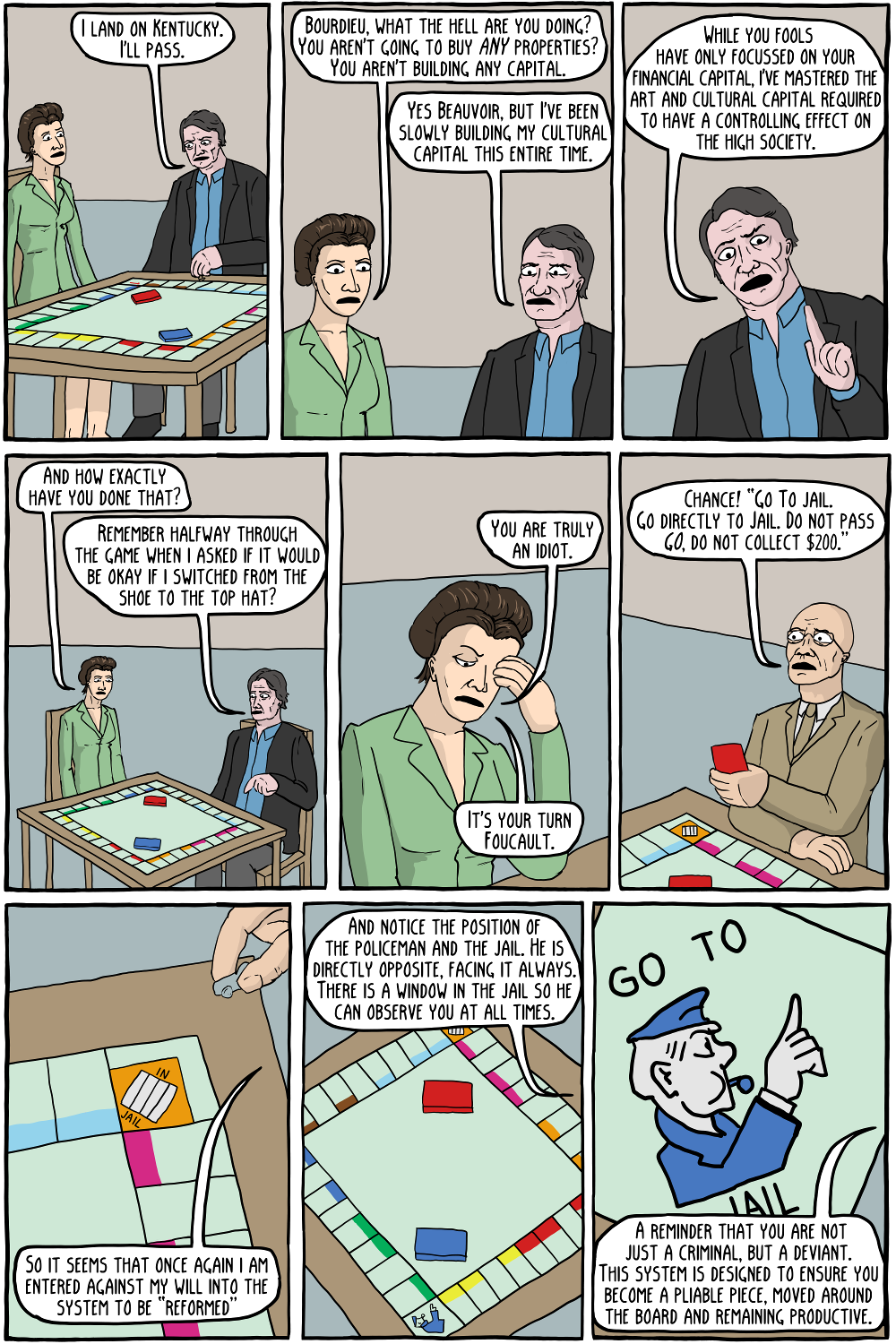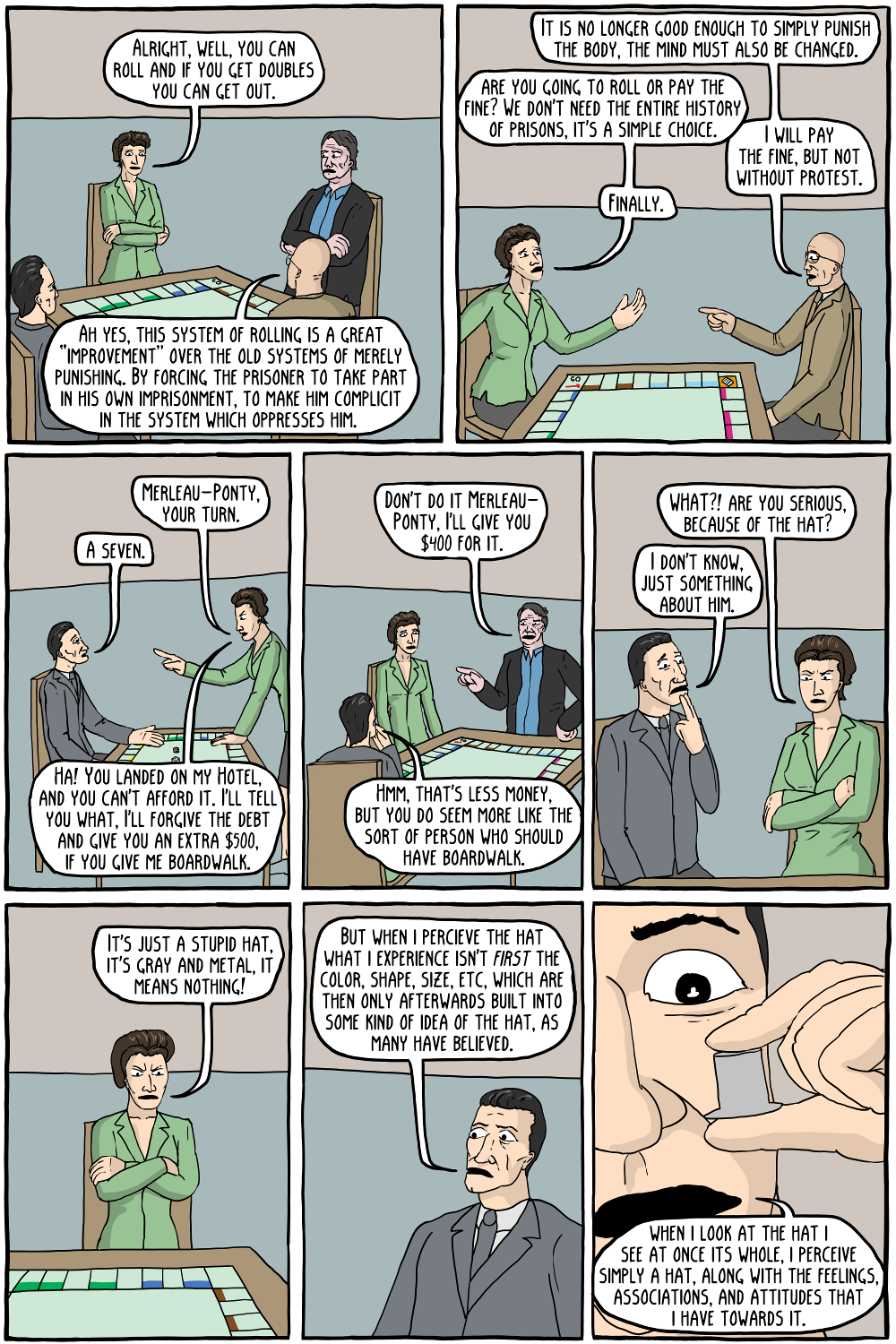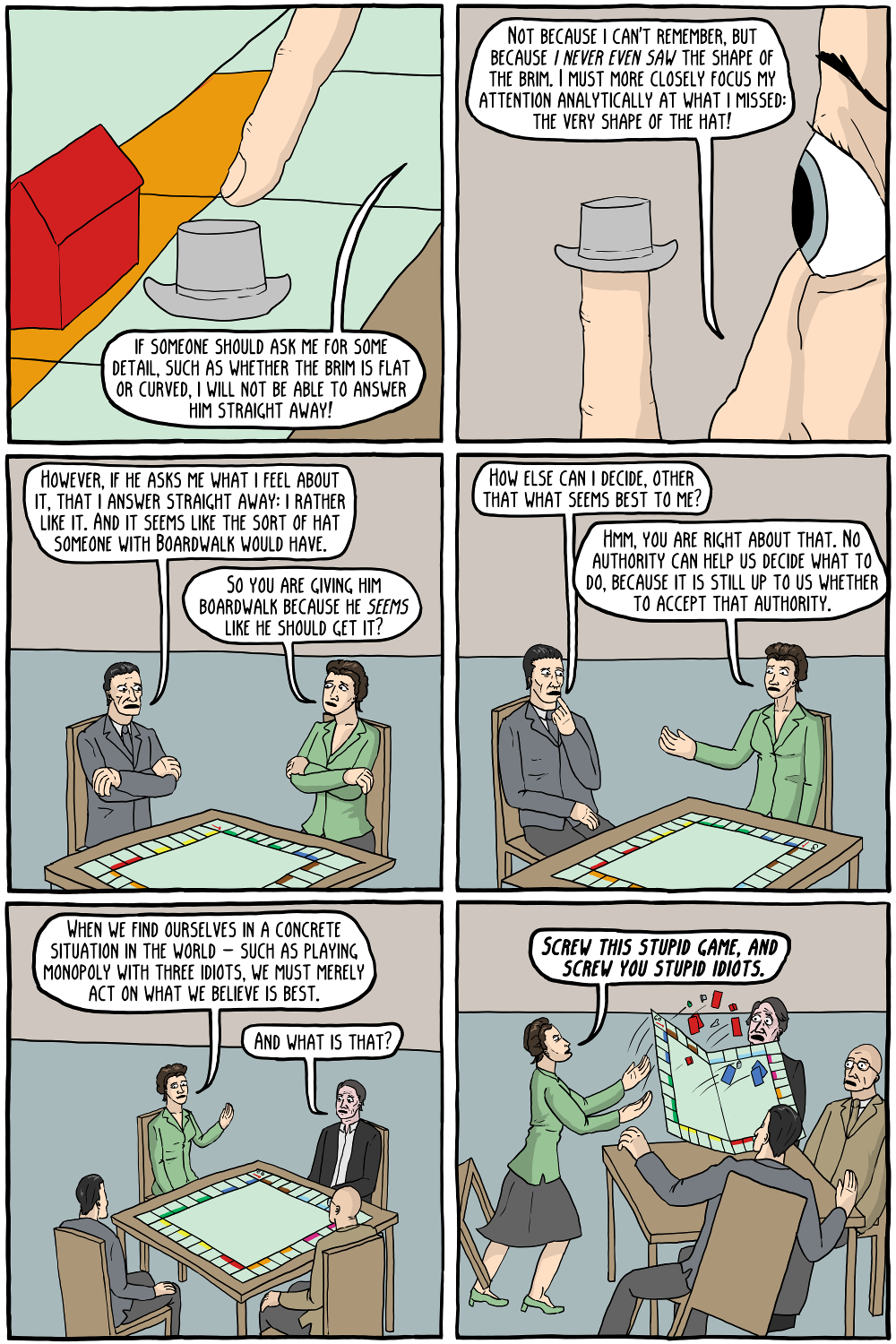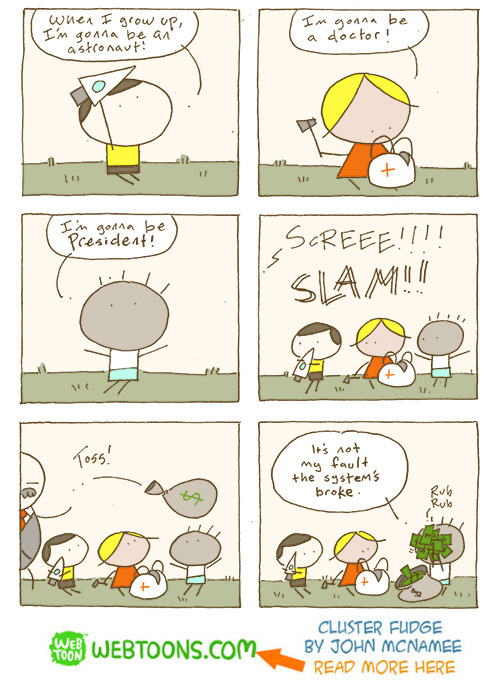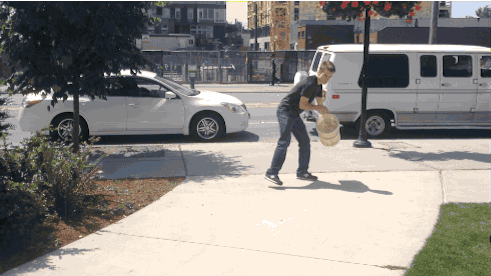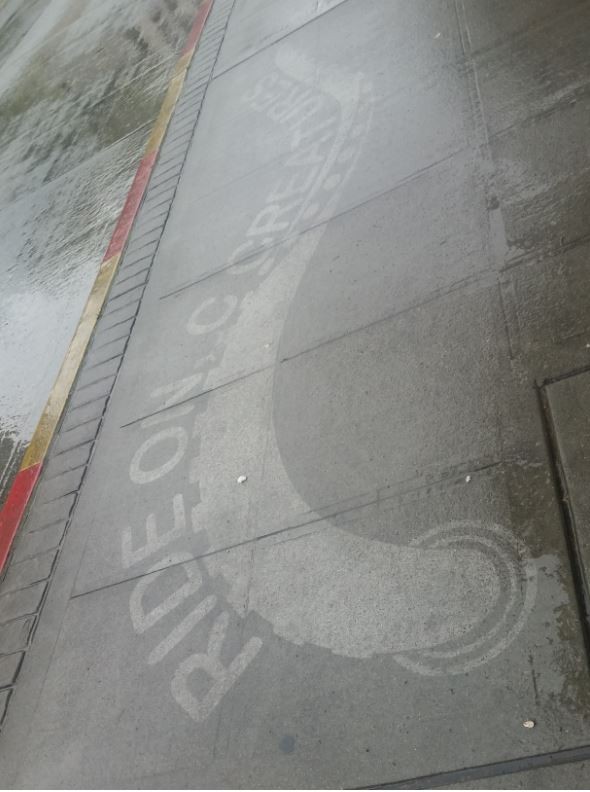 View
View
Matthew
Shared posts
San Francisco Deduces the Exact Center of the City, for Some Reason
37° 45’ 16.356940” North by 122°26’33.16387” West. That’s the precise geographic center of San Francisco, according to city surveyors who worked it out using a $35,000 positioning gadget and data from nearly a dozen satellites.
Of course, that location is almost certainly incorrect, to believe a beautifully surreal story by the Chronicle’s Steve Rubenstein. But first, here’s the newly crowned city center, which the San Francisco Public Works department has adorned with a shiny metal plaque:

Zooming in reveals the center is on a sidewalk, and save for a few feet could’ve easily been inside a dumpster:
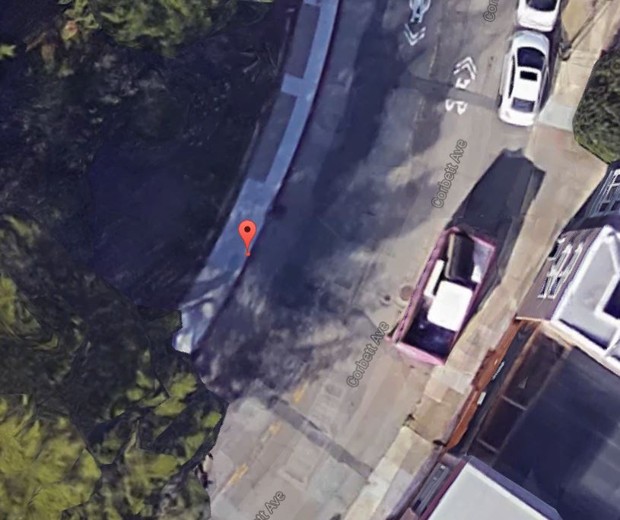
Why did the city go through the effort of sussing out this teensy point? Nobody seems able to explain it, reports the Chronicle:
“It’s important to know where the center of the city is,” [Public Works Director Mohammed] Nuru said, although when asked to explain why, he said he didn’t really know. After thinking it over, he suggested that once you know where the center is, you can tell how far some other place is from it, although he added that he didn’t know what that was good for, either.
Carto-nerds wishing to hike to this hallowed point should also know it’s not the center the surveyors actually plotted. That would be located a couple dozen feet up a hill in some bushes; the sidewalk just seemed like a better place for a plaque. And sticklers for the truth should know if you consider parts of San Francisco removed from the peninsula—Treasure Island, for example, or the Farallon Islands some 30 miles away—the actual center might be a bit eastward or in the frigid Pacific Ocean, respectively.
Exercise Research Is Ignoring Female Athletes
Sometimes the obvious bears repeating: Women aren’t just smaller men with breasts. Women tend to need more sleep, for example, and process pain differently, and may break down some drugs differently. (In 2013, the FDA issued its first sex-specific dosing guidelines, for sleeping pills.)
But still, broadly speaking, medical research has...More »
Tatooine Rainbow
Tatooine Rainbow
Since rainbows are caused by the refraction of the sunlight by tiny droplets of rainwater, what would rainbow look like on Earth if we had two suns like Tatooine?
—Raga
A planet with double suns would have double rainbows.
Or rather, quadruple rainbows. Our rainbows here on Earth are already double rainbows—there's a second, fainter bow above the main one. You can't always see this second rainbow, since the clouds need to be just right, so people get excited when they see one.

The area between the two rainbows is darker than the area outside because raindrops reflect light more strongly in certain directions. That region has a name, by the way—it's called Alexander's dark band.

The first and second rainbows are the only ones you can see easily, but there are actually many more bows beyond those two, each one fainter than the last. Rainbows are formed by light bouncing around in raindrops, and the different bows are formed by different paths the light can take. The main rainbow is formed by the most common paths through the droplet, and other paths—where some of the light bounces around in more unusual ways—make the fainter second, third, fourth, and even fifth rainbows.

Usually, only the first and second rainbows are bright enough to see; it was only in the last five years that anyone took pictures of the third, fourth, and fifth rainbows.
Rainbows appear on the other side of the sky from the Sun, so to figure out what a double rainbow would look like on a planet with two suns, we need to figure out where the suns usually appear in the sky on that kind of planet.
There are planets with two suns out there, although we didn't know that for sure until recently. Double-star planets come in two main varieties:
![[actual size]](/imgs/a/150/binary.png)
In the first kind of system, the two stars are close together and the planet goes around them far away. This kind of planet is called a circumbinary planet. In the second kind of system, the two stars are farther apart, and the planet orbits one of them[1]Not necessarily the bigger one. while the other stays far away. This kind of planet is called [the other kind of planet].[2]I'm sorry, I've just never learned a good word for these.
If you lived on [the other kind of planet],[3]Sorry. the two Suns would spend most of the year in different parts of the sky. Depending on how big they were, they may also be very different in brightness. If you were orbiting the larger star, the smaller one might be no brighter than the Moon,[4]Which would still be bright enough to cast a rainbow! or even look like an ordinary planet or star.
Tatooine, in Star Wars, looks like it's probably a circumbinary planet. The two stars appear pretty close together in the sky and similar in color and size, so it seems reasonable to guess they're actually near one another, with Tatooine orbiting both of them. Two suns would create two overlapping rainbows. The main bow of the rainbow is a circle about 84 degrees across, centered in the sky exactly opposite the Sun.[5]This is why you never see more than half of a rainbow above the horizon. If the center of the rainbow were above the horizon, it would mean the Sun was below it behind you, so there wouldn't be sunlight to make a rainbow in the first place. The farther apart the two suns were, the farther apart the rainbows would be. If the two suns were 84 degrees apart, the main bows of the two rainbows would barely touch.
A pair of suns 84 degrees apart would be possible around [the other kind of planet], but not around Tatooine-type[6]If Star Wars had just used the other kind of planet, we could use its name for them and solve this problem. circumbinary planets. The reason is simple: A planet orbiting two stars can't get too close to them or its orbit becomes unstable. If it gets too close, the irregular tugging from the gravity of the two stars as they orbit will eventually cause the planet to crash into one of them or get flung out of the system.
For a system with two similar-sized stars, this "critical radius" is around six times the distance between the two stars.[7]This is a very rough number; it can range from four to eight depending on the exact arrangement. We've found a lot of planets close to that critical radius, which suggests that maybe they slowly migrate inward until they reach it and are ejected or destroyed. Strangely, we haven't found many big Jupiter-sized planets around binary stars in general; we should be seeing them if they're there, so the lack of them is a mystery. This means that the two suns would never get more than about 20 degrees apart in the sky:

This tells us that the two rainbows in a Tatooine-like system would always overlap.[8]Assuming the raindrops are made of water, or something with similar refractive properties. The colors would blend together where the bows crossed, and the dark bands would too.
I suppose doubling all the rainbows would also double the number of pots of gold at the end of each rainbow.[9]Come to think of it, do our rainbows have one pot of gold or two? I've never really thought about it. And it's not just pots of gold; I guess we'd need to rethink all kinds of rainbow references.
Overlapping rainbows would be beautiful, but definitely a lot more complicated.

Can China's Futuristic 'Straddling Bus' Finally Become a Reality?
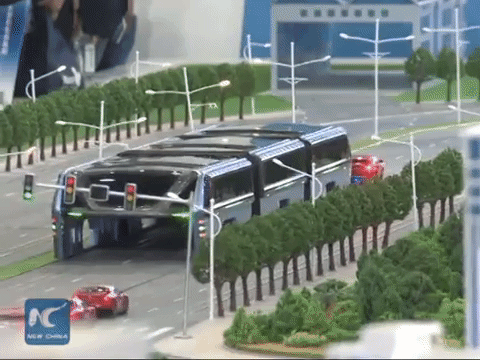
Car ownership in China is soaring, with an estimated 20 million new drivers hitting the roads each year. Cities there can expect no shortage of air pollution and hellish traffic jams. While local governments are hoping that parking regulations and plate restrictions will ease congestion, engineers and designers are trying to find relief in technology.
What if there were a city bus that could carry more than a thousand passengers from one point to another without taking up any space on the road?
As fantastical as that sounds, it’s a solution that Chinese cities like Beijing are actually considering. Participants at the 19th International High-Tech Expo in Beijing this weekend watched excitedly as a tiny “straddling bus” gobbled up cars and spit them back out as it glided above the traffic in a model city. It’s a replica of what could be the future of China’s public transport.
Related Story

Mapping America's Commutes in Colorful GIFs
A new visualization makes daily work travels look fun.
The bus would span two traffic lanes and carry up to 1,400 passengers. It would travel up to 40 miles an hour above street level on a special track, allowing regular cars under 7 feet high to freely pass underneath. (As a extra touch, its underbelly even simulates the sky.)
More importantly, it would run on electricity and take the place of 40 buses, which could cut annual fuel consumption by 800 tons and carbon emissions by almost 2,500 tons, according to an interview with the chief engineer, Song Youzhou, conducted by China’s official news agency, Xinhua. And it would be less expensive than a subway system as it doesn’t involve digging up the ground.
The idea, while innovative, isn’t new. As TreeHugger pointed out, two architects—Craig Hodgetts and Lester Walker—dreamed up a similar concept back in 1969 as part of their “immodest proposal” for redesigning New York City. They called it the Bos-Wash Landliner, as it would run between Washington, D.C., and Boston. Writing in New York Magazine and providing a drawing that looks like something out of a classic Nintendo game, the authors expressed even bigger ambitions:
The Bos-Wash Landliner, bound for Boston, streaking through the 86th street reservoir area of Central Park … just about to drop off and pick up busloads of commuters before it resumes full speed of 200 miles an hour. It rides on nearly friction-free air cushion bearings (those plates which you see hugging the sides of the road are something like vacuum cleaners in reverse; the horses connecting them to the turbine-powered, ducted fan-jets above are filled with air). The fan-jets themselves have a regenerator cycle, which means no hot exhaust—important since the Landliner will be zooming only 16 feet over your head if you are driving along the freeway.
But since then, the straddling bus idea has stayed just that—an idea. Song first introduced his version in 2010. While it grabbed international headlines, it never came to fruition. At the time, Beijing said that it had plans to start building roughly five miles of track by the end of the year. But three years down the line, some news outlets began expressing doubt when they saw that no tracks had actually been laid out.
This time, according to the Xinhua news agency, the Beijing-based company Transit Explore Bus is currently building a life-size model in Changzhou and they plan to test it in July or August. If successful, it could help ease China’s transit problem, although it would still take years for the country to bring down its pollution levels. But as I previously wrote, new technology would have to encourage China’s 1.4 billion people to change their behavior. That includes changing their attitudes toward air pollution and the desire to own a car.
Gender pay gaps for major U.S. occupations
As we all know these days, there exists a gender pay gap across most major professions in the United States. The Wall Street Journal charts the average differences for 446 occupations.
Occupations are charted from least to greatest gap horizontally, and the vertical axis represents salaries. Blue dots represent men’s average salaries and the pink represents women’s, and a vertical line connects the two. So the longer the vertical, the bigger the gap.
There’s an interesting use of the fish eye effect as you mouse over so that you can see the individual lines. There’s also a search box to find an occupation of interest. I just wish the two were closer linked with a zoom on search, instead of only a highlight.
Tags: gender, pay gap, Wall Street Journal
Oklahoma Passes Bill That Effectively Makes Abortion Illegal
BREAKING: The Oklahoma Legislature has passed a bill that would make performing an abortion a felony.
— The Associated Press (@AP) May 19, 2016
For the first time since Roe v Wade, a US state has passed a bill that effectiely makes abortion illegal.
With a vote of 33-12, the Oklahoma Legislature passed a bill that makes it illegal for doctors to perform abortions by preventing them from obtaining or renewing a license to practice medicine in Oklahoma. So, while abortion is still technically legal, any doctor who performs one in Oklahoma risks their livelihood.
According to CBS News, the bill’s sponsor, Republican Sen. Nathan Dahm, sees this as a first step toward overturning Roe v Wade. He says, “Since I believe life begins at conception, it should be protected, and I believe it’s a core function of state government to defend that life from the beginning of conception.” Of course, he doesn’t seem to concern himself too much with the lives of the chattel women carrying those babies, nor for the lives of those babies once they make it out of their wombs. But whatevs.
The bill was passed without discussion or debate. However, it is receiving pushback. Sen. Ervin Yen, a Republican Oklahoma City senator and the only physician in the Senate, called the bill “insane” and voted against it.
Meanwhile, Amanda Tallen, attorney for the New York-based Center for Reproductive rights said, “Oklahoma politicians have made it their mission year after year to restrict women’s access vital health care services, yet this total ban on abortion is a new low. The Center for Reproductive Rights is closely watching this bill and we strongly urge Governor Fallin to reject this cruel and unconstitutional ban.”
There’s reason for hope, however. Try though they have to make anti-abortion bills like this stick, the fact is that every single time the Oklahoma Legislature has passed something like this, it has never become a law, because they have all been unconstitutional. It’s reasonable to assume that the same will happen here. After all, as Senate Democratic leader Sen. John Sparks pointed out, alluding to the Legislature’s May 27th adjournment and the fact that they still have a $1.3 billion budget hole to worry about, “Republicans don’t have an answer for their failed education policies, failing health care policies and failing fiscal policies, so what do you do in that situation? You come up with an emotional distraction. That’s what this bill is.”
Keep fighting, Oklahoma.
(featured image via Oklahomans for the Arts/Flickr)
—The Mary Sue has a strict comment policy that forbids, but is not limited to, personal insults toward anyone, hate speech, and trolling.—
Follow The Mary Sue on Twitter, Facebook, Tumblr, Pinterest, & Google+.
I/O: Building the next evolution of Google
The Google assistant
When we think of the Google search experience today—a rich panel of information on [Zika virus], or an alert telling you your flight is delayed—it’s striking to see how far things have come from the early days of 10 blue links. Many of these advances have been thanks to machine learning and artificial intelligence—specifically, areas like natural language processing, voice recognition and translation—and they have helped us build an increasingly useful and assistive experience for users. They are the ingredients that make Google speech recognition the most accurate in the world, and that let you take a picture of a sign in Chinese and see it translated into English.
Progress in all of these areas is accelerating, and we believe we are at a seminal moment. People are increasingly interacting naturally with Google, and aren’t just looking for the world’s information but actually expecting Google to help them with their daily tasks.
Which is why we’re pleased to introduce...the Google assistant.
The assistant is conversational—an ongoing two-way dialogue between you and Google that understands your world and helps you get things done. It makes it easy to buy movie tickets while on the go, to find that perfect restaurant for your family to grab a quick bite before the movie starts, and then help you navigate to the theater. It’s a Google for you, by you.
The assistant is an ambient experience that will work seamlessly across devices and contexts. So you can summon Google’s help no matter where you are or what the context. It builds on all our years of investment in deeply understanding users' questions.
Today we gave a preview of two new products where you’ll soon be able to draw on the Google assistant.
Google Home
Google Home is a voice-activated product that brings the Google assistant to any room in your house. It lets you enjoy entertainment, manage everyday tasks, and get answers from Google—all using conversational speech. With a simple voice command, you can ask Google Home to play a song, set a timer for the oven, check your flight, or turn on your lights. It’s designed to fit your home with customizable bases in different colors and materials. Google Home will be released later this year.
Allo and Duo
Allo is a new messaging app that also comes complete with the Google assistant, so you can interact with it directly in your chats, either one-on-one or with friends. Because the assistant understands your world, you can ask for things like your agenda for the day or photos from your last trip. If you’re planning a dinner with friends, you can ask the assistant to suggest restaurants nearby, all in one thread.
Allo includes Smart Reply, which suggests responses to messages based on context, and comes with fun ways to make your chats more expressive, including emojis, stickers, and the ability to get creative with photos. There’s also an Incognito mode that provides end-to-end encryption, discreet notifications, and message expiration.
In addition to Allo, we’re introducing Duo, a companion app for one-to-one video calling. With Duo, our goal is to make video calling faster and more reliable, even on slower network speeds. We also introduced a feature called Knock Knock, which gives you a live video of the other caller before you answer.
Best of all, both Allo and Duo are based on your phone number, so you can communicate with anyone regardless of whether they’re on Android or iOS. Both apps will be available this summer. Read more here.
Android N, Wear, VR, and Instant Apps
Today we shared details about what’s coming in Android N, including better performance for graphics and effects, reduced battery consumption and storage, background downloads of system updates, and streamlined notifications so you can power through them faster, and updated emojis including 72 new ones. And we want your help coming up with a name for N that can be a sweet successor to Marshmallow. Read more and help us #NameAndroidN at Android.com/N.
On top of Android N, we’ve built a new platform for high quality mobile VR called Daydream. Together with Android manufacturers, we're working on upcoming phones, and sharing designs with them for a VR viewer and controller that will be really immersive, comfortable and intuitive to use. Your favorite apps and games will be coming to Daydream too, including Google's—like YouTube, Street View, Play Movies, Google Photos and the Play Store. More to come this fall.
We also previewed Android Wear 2.0, including a revamped user experience and standalone apps that run right on the watch, no matter where your phone is or even if it's off.
Finally, we’re introducing Android Instant Apps—which let you run Android apps instantly, without requiring installation.
Firebase
Today we launched a big expansion of Firebase, our most comprehensive developer offering to date. Going beyond a mobile backend, the platform helps developers quickly build high-quality apps, grow their user base, and earn more money across iOS, Android and the mobile web.
Tackling global challenges with smarter tools
Machine learning and AI are changing not only computing, but also the way in which we tackle problems we’ve never been able to solve before. The opportunities are even greater when we harness the powers of open-source tools to make them available to the broader developer and researcher community. Imagine what we could do if we work together and use these technologies to tackle challenges in climate change, health care or education. As our machine learning and AI capabilities get smarter and more versatile, these possibilities are starting to appear on the horizon. These are very exciting times indeed.
Posted by Sundar Pichai, CEO, Google https://4.bp.blogspot.com/-Nilr6F7t1AU/Vzx1LP1d1SI/AAAAAAAASUc/rkjvgsCCl3kH3k331gHAWxMC05MZWxNiwCLcB/s1600/GH_Livingroom.jpg
This Device Could Allow Lungs to Stay Alive Even After Being Removed From a Body
The XPS by XVIVO Perfusion, also known as “the box,” is currently still in the clinical-trial stage, but if it works it could drastically improve survival rates for people in need of lung transplants.
Produced by Eva Hill, written by Cait Munro.
An eye for detail: Zoom through 1,000 artworks thanks to the new Art Camera from the Google Cultural Institute
Zooming into these images is the closest thing to walking up to the real thing with a magnifying glass. This is why we’re so excited about our new Art Camera—a custom-built camera ready to travel around the world to bring people more of these ultra-high-resolution images than ever possible before.
The Port of Rotterdam by Paul Signac, Museum Boijmans Van Beuningen
A gigapixel image is made of over one billion pixels, and can bring out details invisible to the naked eye. So creating digital images in such high resolution is a complex technical challenge. You need time, highly specialized and expensive equipment, and only a few people in the world can do the job. In the first five years of the Google Cultural Institute, we’ve been able to share about 200 gigapixel images. But we want to do much more. That’s why we developed the Art Camera.
The Art Camera is a robotic camera, custom-built to create gigapixel images faster and more easily. A robotic system steers the camera automatically from detail to detail, taking hundreds of high resolution close-ups of the painting. To make sure the focus is right on each brush stroke, it’s equipped with a laser and a sonar that—much like a bat—uses high frequency sound to measure the distance of the artwork. Once each detail is captured, our software takes the thousands of close-up shots and, like a jigsaw, stitches the pieces together into one single image.
Many of the works of our greatest artists are fragile and sensitive to light and humidity. With the Art Camera, museums can share these priceless works with the global public while ensuring they're preserved for future generations. We want to give museums the tools they need to do this important work, so we're sending a fleet of these cameras from museum to museum around the world—for free.
The Art Camera will dramatically increase the scale and depth at which museums are able to provide access to our shared cultural heritage to anyone around the world. For example, if you wanted to see Van Gogh’s six famous portraits of the Roulin family up close, you’d need to travel across the Netherlands then over to LA and New York. Now the Art Camera can travel for you. It’s already captured the Portrait of Armand Roulin, which you can explore alongside the rest of the family, all in one place.
Today, we’re sharing the first thousand ultra-high resolution images of artworks from artists including Pissarro, Signac, Rembrandt, Van Gogh, Monet and many more from museums across Australia, India, the Netherlands, Brazil and everywhere in between. As we prepare to celebrate International Museum Day and welcome more than 25 new museums on the Google Cultural Institute, we want to thank everyone who worked with us to test the new camera in the recent months. Thanks to their work, today you can start zooming and explore more art in the details than ever before!
Posted by Ben St. John, Engineer, Google Cultural Institute Ben St. John Engineer Google Cultural Institute
A Cyclist Is Setting Out to Prove You Can Travel Around the U.S. by Bike and Rail

INWOOD, N.Y., 9:30 a.m. — At the corner of Broadway and Dyckman Street at the northern tip of Manhattan, Elena Studier is doing some final checks on her bike. She scans to make sure there’s air in the tires and that the brakes are working. Her backpack, a giant green Opsrey, is packed with the bare minimum. For the next 38 days, she’ll be traversing the country using only a bike (hers is named Stevie) and Amtrak, making 18 stops in various cities along the way.
The ten-mile ride down the Manhattan Waterfront Greenway from Inwood to Penn Station is just the first leg of her trip. I’m tagging along with representatives from Amtrak and the East Coast Greenway Alliance—an organization working to connect the major cities along the eastern seaboard by bike paths—to see her off. We cycle away from the sleepy streets of weekend-morning Inwood and over to the Hudson. The air is cool and salty; to our right, across the river, are quiet, wooded cliffs; to the left, the Metro-North Hudson line tracks.
It’s hard to believe this bucolic stretch of is part of jam-packed Manhattan; that after an hour’s ride we’ll be in the midst of Midtown, navigating our bikes through crowds of tourists toward the Amtrak waiting area in Penn Station. But integrating these diverse transit experiences is the point of Studier’s trip.
As an intern for the National Association of Railroad Passengers, whose aim is to boost the interconnectivity and ridership of the U.S. railways, Studier devised this journey to demonstrate the possibility of crossing the country without the use of a car. Throughout the course of her Summer by Rail, which officially began May 15 and will conclude in Washington D.C.’s Union Station on June 20th, Studier will track between cities along the outer edge of the country, speaking with local transit developers, advocacy groups, and Amtrak passengers to document the need for integrated, accessible public transportation in places as small as Bloomington-Normal, Illinois and as large as the Bay Area.
“This is a lifestyle that many more people are gravitating toward,” Studier says. “It’s becoming more important for people to feel like they can get by in the modern world without necessarily having a car, but [by] relying instead on public transportation—and transportation in general—that’s really integrated and manages to serve a variety of needs,” she adds.
The expansion of Amtrak’s walk-on bike service last year has aided the accessibility of railroad travel. First introduced in 2013, the wildly convenient alternative to the rail system’s bike-box policy has since expanded to 10 lines; the Capitol Limited became the first overnight train to offer the roll-on service last September. Speaking to the Chicago Tribune, Melody Geraci, the deputy executive director at the Active Transportation Alliance, said that as a result of the service, “more people are interested in making inter-modal connections without having to worry about driving and parking a car.”
It’s those extra miles between an Amtrak stop and a city’s public transportation system, Studier says, that often mar the convenience of multi-city rail travel. Incorporating a bike as connective tissue certainly helps. “Rail travel has a tendency in the public discourse to be seen as nostalgic,” Studier says. “I wanted to show that it’s actually a very current, and needed, system.”
And yet, there’s room for improvement. On its website, the NARP says it “believes the current Amtrak system is skeletal at best.” Its goal is to increase the number of rail route miles from 22,000 to 45,000—roughly flush with the size of the current interstate highway system—and put 80 percent of the population within 25 miles of a train station by 2025. In a recent report, the NARP calculated $209 billion worth of languishing rail improvement projects across the country. In addition to boosting mobility for underserved populations (parts of rural Wyoming and South Dakota are still completely inaccessible by rail), the completion of those projects would jolt some life into the economy—the NARP estimates that 20,000 jobs are created for each billion spent on rail projects.
A photo posted by @railpassengers on
Studier’s trip will bring her face-to-face with how these abstract figures play out on the local scale. In Minneapolis-St. Paul, Studier will document the effects of the multi-billion dollar Green Line project, completed in 2014, but she’ll also consult with the Adventure Cycling Association and the Whitefish Visitor’s Bureau in Glacier National Park to understand the importance of integrated transit systems for smaller, more remote towns. “In a place like Whitefish, a few hundred thousand dollars of intrastructure investment can make a huge difference,” says Sean Jeans-Gail, the vice president of NARP. “[Towns like Whitefish] really want to get people out there on their bikes by train, because it’s an important economic lifeline for them.” By stitching together these different stories about transit systems across the country, Studier’s project will become a tangible study in the need for cities and town across the country to consider the future of their transit systems on both a national and a local scale.
“Interconnectivity is a message that people all across the country are really prioritizing; it’s something you’re starting to see in plans and developments,” Studier says. “I’m just hoping to amplify it.”
Bad News: Two-Factor Authentication Pioneer YubiKey Drops Open Source PGP For Proprietary Version
That's why it's fairly disappointing to learn that Yubico, the company that makes them, has decided to drop an open source implementation in its latest offering. After some people started asking about this on GitHub a few days ago, Yubico's Engineering Lead Dain Nilsson explained:
The implementation is not open source, that is correct. We have both internal and external review of our code to ensure that it is secure. It's important to remember that open source code is no guarantee that bugs/vulnerabilities will be detected as the bug you've linked to demonstrates quite well. The bug was inherited from the upstream project which ykneo-openpgp is based on, and was NOT detected by any audit of the source code. It was interaction with the device itself which led to its discovery.While I'm sure that Yubico's intentions were good here, this has raised a lot of concerns and has led to other former fans of YubiKeys withdrawing their endorsements of the devices. Encryption is tricky. There are almost always vulnerabilities and bugs -- a point we've been making a lot lately. But the best way to fix those tends to be getting as many knowledgeable eyes on the code as possible. And that's not possible when it's closed source.
We're all for open source, and we try to open source as much of our code as possible when and where it makes sense, but in this case it was determined not to be so. One reason is that on the YubiKey NEO, each applet runs in its own sandbox, isolated from the rest of the system and can be audited/reasoned about on its own. This is not the case on the YubiKey 4, where each part of the system interacts with several others. Another reason that ykneo-openpgp was implemented as an open source project (aside from being able to leverage an existing project) was that it was useful for others, as it can run on a variety of devices. Again, this is not the case for the implementation running on the YubiKey 4.
Yubico, also, doesn't seem to have reacted well to people complaining. After one commenter was marginally aggressive, saying "Everyone that does not have shit for brains knows that security through obscurity doesn't work..." Nilsson closed down the thread and noted: "Further hostility against the company or our users will not be tolerated in this forum, and will be met with bans." That seems... tone deaf, at best, and it makes the company sound unwilling to listen to the concerns of its customers.
While there may be legitimate reasons that Yubico made this switch, it quite reasonably has many former supporters more worried about using its solution, and many are now looking at alternatives. Yubico had been so associated with this market for a long time that it was becoming basically "the" provider of these kinds of keys. But it may have just helped the competition quite a bit.
Permalink | Comments | Email This Story
This Bike Alarm Literally Explodes in Thieves' Faces

To prevent a thief from ganking your bike, you can try securing it with a U-lock or heavy-duty chain. Or, for fans of the bombastic approach, there’s now an alarm that detonates when disturbed, rousing the whole neighborhood with an echoing boom.
The “Bike Mine” is the dastardly creation of London’s Yannick Read, a longtime bike-hacker who’s also made a cycle with a deafening train horn and another that shoots flames at motorists who get too close. The device consists of a bit of titanium wire, a spring-loaded trap, and a “saluting cartridge” typically shot off at military ceremonies and royal birthdays. It latches onto your frame with Velcro and, when somebody moves the bike, detonates in a 150-decibel cacophony of sparks and smoke, like so:
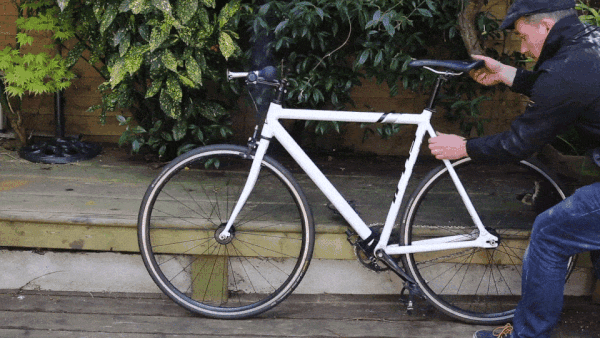
The purpose of the “Bike Mine” isn’t to inflict semipermanent tinnitus on thieves, though that might be a side effect—150 decibels is as thundering as a jet engine and reportedly can rupture eardrums. Rather, Yannick hopes the explosion will both wake up the owner and cause bandits to panic and flee:
In the war against thieves, your goal should be to get them caught in the act.
For example, with motorbikes, the most common technique they use is lifting it off of the ground and loading into a van. Quick. Easy. Quiet. Think your bike is too heavy to be lifted in this way? Thieves have thought of that. They lash a scaffold tube to the front and back of the bike and share the weight between four. When it comes to bicycles, it’s even easier.
BIKE MINE is extremely hard for a thief to detect and when they do, it’s too late: You are awake. Your neighbour is awake. They are running away as fast as they can.
Yannick’s put the project on Kickstarter (about $70 for a “Bike Mine” and three cartridges), where he hopes to raise enough cash to make each device himself. Here’s hoping in the future he’ll release public schematics for the bomblets, so bike owners can sow terror in the hearts of thieves the world ‘round.
H/t ETA
Translate where you need it: in any app, offline, and wherever you see Chinese
First, say hello to Tap to Translate on Android. We know millions of you painstakingly copy-paste text between Google Translate and other apps. Now, you can just copy the text of a chat, comment, song lyric, etc. in whichever app you’re using, and a translation will pop up right there—no need to switch apps:
Watch the video to learn more. Tap to Translate works for all 103 of Google Translate’s languages on any Android phone running Jellybean (4.2) and above.
Next, Offline Mode now works on iOS, and joins Android in using small offline packages. We know that many of you found the previous packages too big to download on unreliable data connections or to keep on your phone’s limited storage. That’s why we shrunk them by 90 percent, to a much more manageable 25 MB each.
Offline Mode is easy to set up: Just tap the arrow next to the language name to download the package for that language, and then you’ll be ready to do text translations whether you’re online or not—and it works with Tap to Translate too. We’ve just added a Filipino language pack, bringing our total number of offline languages to 52.
Finally, we’re adding Word Lens in Chinese. It’s our 29th language for instant visual translation, and it reads both to and from English, for both Simplified and Traditional Chinese. Try it on menus, signs, packages, and other printed text. As with all Word Lens languages, it works offline.
With Tap to Translate, improved Offline Mode, and Word Lens in Chinese, we hope you’ll find the latest version of Google Translate a helpful companion. These updates are rolling out over the next few days.
Posted by Barak Turovsky, Product Lead, Google Translate
https://1.bp.blogspot.com/-SyxzlzaC5j0/VzLVZd7IgVI/AAAAAAAASRM/4vJfEfa48II27sPklESN_hse40ohePabwCLcB/s1600/Milk_Chinese-English.gif Barak Turovsky Product Lead Google Translate
Minimalist Posters of Libraries Around the World

Library interiors usually get all of the glory—spiral staircases, soaring walls of books, and that musty, delightful, smell.
The Portuguese architect André Chiote thinks it’s time to start paying more time to the exteriors. “Libraries are exceptional buildings,” he says. They’re points of reference in cities, and their distinctive architecture sets them apart.
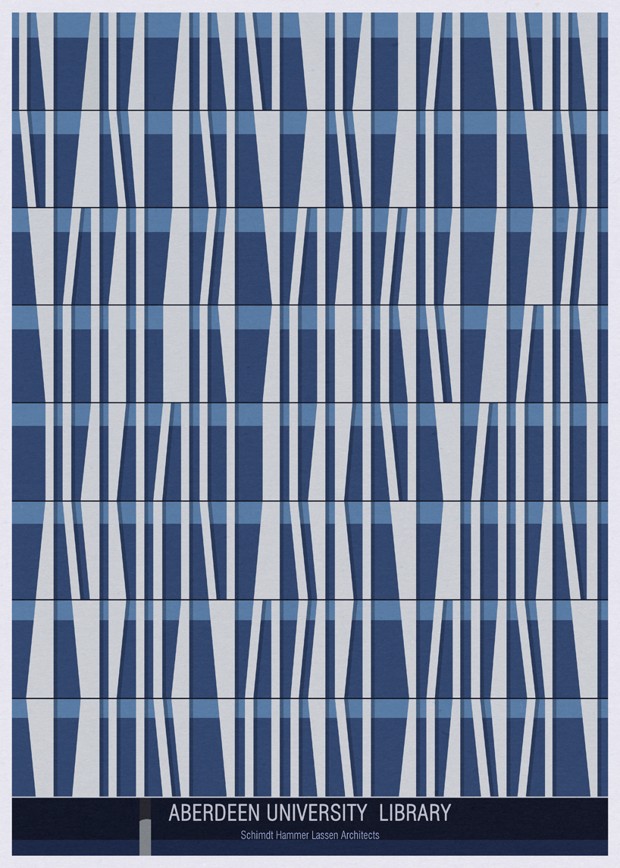
Chiote’s series of graphic illustrations highlights the unique structural details of these buildings around the world. He’s drawn the Delft University Library, the Seattle Public Library, and the Brasilia National Library, among others. His favorite to work on was the Viana do Castelo Municipal Library in Portugal—it’s close to him and designed by the architect Álvaro Siza. Chiote’s approach to libraries is a bit unusual. His work features no books, but instead depicts abstracted, geometric forms. “You need to already know the building to recognize it,” he says.
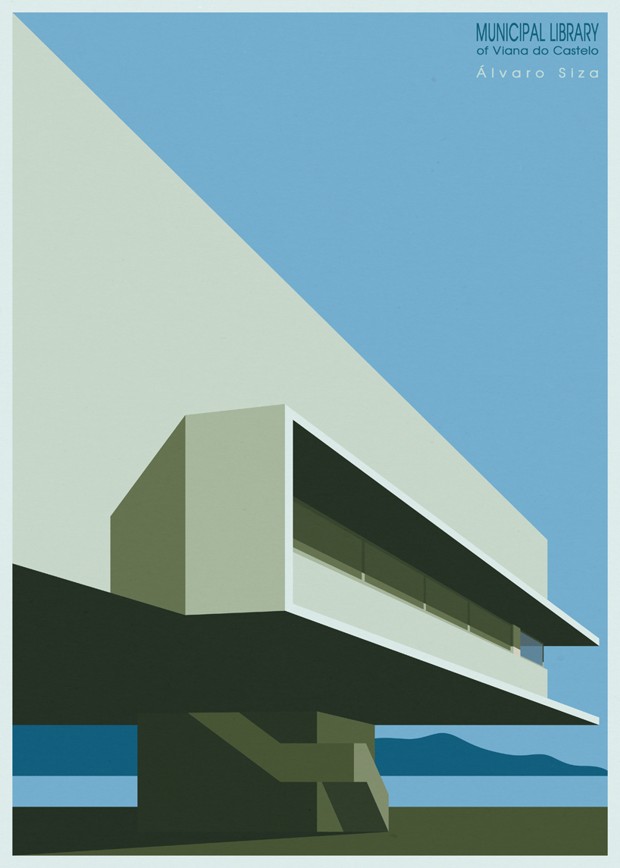
Chiote has previously applied the same minimalist treatment to other municipal buildings; he has a whole series devoted to the 2014 World Cup stadiums in Brazil. But to him, libraries have a special draw. “There is nothing I like more than a wall of books,” he says. Chiote’s designs simply and powerfully highlight the importance of the buildings that house them, too.
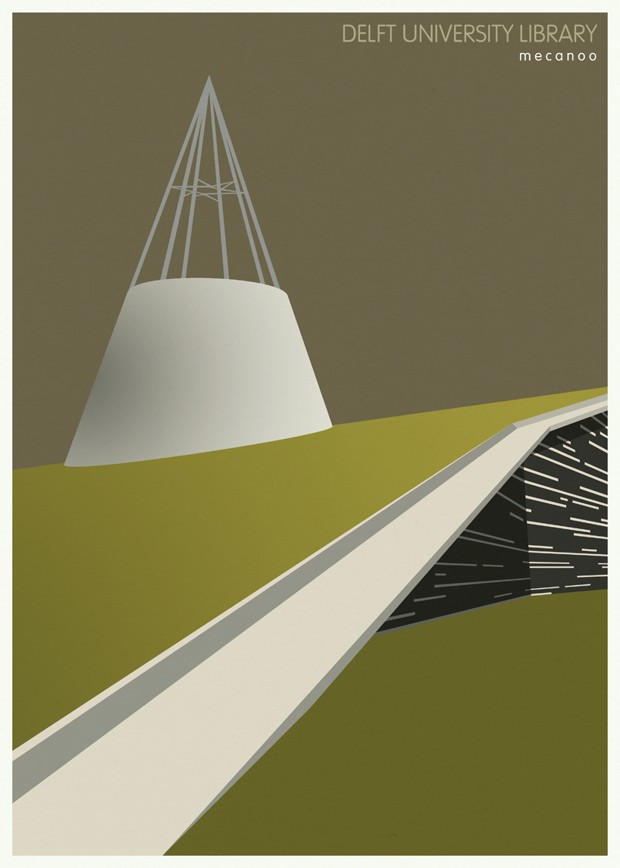

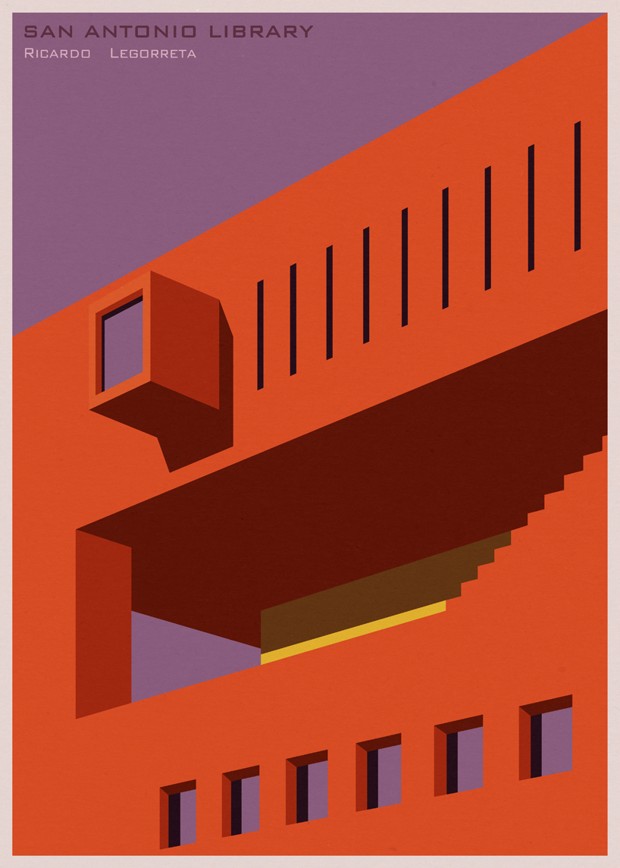
Prints, starting at 15€, at André Chiote Illustration.
Seattle Bus Stops Now Feature Rain-Activated Sea Creatures
Commuters in Seattle are in for unexpected pelagic encounters should they visit certain bus stops. When it rains, ghostly sea creatures now appear on the sidewalk, beckoning them aboard with pincers and large, looping tentacles.

Are these advertisements for a bus service that plunges right into the frigid Puget Sound? Well, no. They’re public artworks meant to celebrate the RapidRide C Line, which due to a public vote got the funds for a recent extension.
For the ephemeral installations, the city collaborated with Rainworks, a local start-up behind an invisible coating that materializes only when wet (which, in Seattle, is quite often). Here’s a camouflaged hopscotch court in West Seattle, for example:
Octopuses and at least one crab hide on sidewalks in West Seattle, Belltown, and South Lake Union, hoisting messages such as All aboard, C creatures and Ride on, C creatures. “This was our first time working with the City of Seattle in an official capacity, after making rainworks ‘guerilla style’ at bus stops for years, and it was a real treat for us,” writes Rainworks. “We hope that the local commuters will see these rainworks and smile, and feel pride for their awesome public transit system!”
Seattleites interested in meeting their new benthic buddies might want to act now, because the average lifespan of Rainworks pieces is two to four months.
John Oliver Took On Junk Science on Last Week Tonight, and It Was Great
This is traditionally the time of the week when internet headlines announce what it was that John Oliver “eviscerated,” “destroyed,” “shellacked,” “murdered,” or “literally gave birth to” this week. It’s a tradition for a reason: Last Week Tonight does a pretty fantastic, consistently hilarious job taking on big subjects, whether...More »
Music timeline plays through decades of top songs
The Year that Music Died from Polygraph is an animated timeline that shows the Billboard top 5 songs since 1956, all the while playing the top song during a given week.
The visualization itself is fairly straightforward, but I like how everything shifts so smoothly. Artist thumbnails move up and down matching their position on the music chart, the number one songs play without sounding jerky, and a counter on the right keeps track of total weeks at number one per artist. [via Waxy]
Annoying Windows 10 Update Request Highlights Its Annoying-Ness On Live Weather Broadcast
But what's a minor annoyance for me can be something altogether different for others. Say, for instance, a live newscast just trying to give its viewers the weather.
Yes, the annoyance that is this popup gets the spotlight treatment on live television, successfully sending the weather forecast askew as it interrupts the broadcast. Is it a funny little occurrence? You betcha. Does meteorologist Metinka Slater deal with the whole thing in stride? Mostly, I guess. But it's the obviously planned lack of options Microsoft's request presents that should piss people off here.
As always the annoying window offered two choices — ‘Upgrade now’, or ‘Start download, upgrade later’. Slater wisely chose neither option and switched to another video source instead.The point is that Microsoft's bull-headed attempt to push its latest operating system on the public wouldn't be so blatant if it simply allowed people, including newsrooms, to shut it the hell up. But that truly is probably asking too much.
Permalink | Comments | Email This Story
So Much For The Fifth Amendment: Man Jailed For Seven Months For Not Turning Over Password
The FBI recently spent more than $1 million for assistance in decrypting a device's contents. It may have overpaid. Alternatives exist, whether it's a $5 wrench or indefinite imprisonment for not helping the government with its prosecution efforts.
A Philadelphia man suspected of possessing child pornography has been in jail for seven months and counting after being found in contempt of a court order demanding that he decrypt two password-protected hard drives.The Fifth Amendment should prevent the government from punishing a person for not testifying against themselves, which is what's being argued by the defendant's representation in its appeal to the Third Circuit. (Although it's actually indirect representation. The government's case is actually against Doe's devices ["United States of America v. Apple MacPro Computer, et al"] and his lawyer is hoping for a stay of the contempt order during the appeal process.)
The suspect, a former Philadelphia Police Department sergeant, has not been charged with any child porn crimes. Instead, he remains indefinitely imprisoned in Philadelphia's Federal Detention Center for refusing to unlock two drives encrypted with Apple's FileVault software in a case that once again highlights the extent to which the authorities are going to crack encrypted devices. The man is to remain jailed "until such time that he fully complies" with the decryption order.
Mr. Doe… has a strong likelihood of success on the second issue: whether compelling the target of a criminal investigation to recall and divulge an encryption passcode transgresses the Fifth Amendment privilege against self-incrimination. Supreme Court precedent already instructs that a suspect may not be compelled to disclose the sequence of numbers that will open a combination lock — clearly auguring the same rule for any compelled disclosure of the sequence of characters constituting an encryption passcode.Doe's rep also argues that the All Writs order obtained by the government has no jurisdiction over Doe or his devices.
Mr. Doe’s first claim is that the district court lacked subject matter jurisdiction. The claim stems from the government’s apparently unprecedented use of an unusual procedural vehicle to attempt to compel a suspect to give evidence in advance of potential criminal charges. Specifically, the government took resort not to a grand jury, but to a magistrate judge pursuant to the All Writs Act, 28 U.S.C. § 1651. (Ex. F at 1).As it stands now, Doe is still being held in contempt of court for refusing to decrypt his devices for investigators. The district court that held him in contempt has refused direct appeal of that order, resulting in the labyrinthine legal strategy of using the government's case against Doe's devices as a vehicle for challenging the lower court's contempt order.
It is black letter law that the All Writs Act never supplies “any federal subject-matter jurisdiction in its own right[.]” Sygenta Crop Protection, Inc. v. Henson, 537 U.S. 28, 31 (2002) (citation omitted). It is equally well-settled that the Act has no application where other provisions of law specifically address the subject matter concerned. Pennsylvania Bureau of Correction v. United States Marshals Service, 474 U.S. 34, 40-42 (1985). The compelled production of evidence in advance of criminal charges is specifically addressed by Rules 6 and 17 of the Federal Rules of Criminal Procedure, which authorize the issuance and enforcement of grand jury subpoenas; and by 28 U.S.C. § 1826(a), which specifies the authorized penalties for a witness who refuses without good cause to give the evidence demanded by the grand jury.
Doe has not been charged, yet he's in prison. Backing up the government's assertions for holding him in contempt are two dubious pieces of hearsay. One is from his estranged sister, who claims to have seen child porn on Doe's computer, but can't actually say whether it was located on the devices the government is seeking to have decrypted. The other is from some sort of law enforcement encryption whisperer, who can apparently see things in the scrambled bits.
The government’s second witness was Detective Christopher Tankelewicz, a forensic examiner with the Delaware County District Attorney’s Office. He testified only that it was his “best guess” child pornography would be found on the hard drives. (Ex. J at 346). According to Tankelewicz’s understanding of the Freenet online network (in which he admits having no training), there were signs on an Apple Mac Pro computer seized with the hard drives of a user accessing or trying to access message boards with names suggestive of child pornography. (Ex. J at 306, 311-312, 339-340). In rather ambiguous testimony, Tankelewicz did not appear to say this meant any image traded over these boards was on the hard drives. (See Ex. J at 303-317, 336-340, 345-350). Instead, he identified a single image he believed there to be a “possibility” was on the drives. (Ex. J at 308-309). As he described it, the image was of “a four or five-year-old girl with her dress lifted up, but the image itself was small so you really couldn’t see what was going on with the image.” (Ex. J at 308).No one wants to see a sex offender walk away from charges, but at this point, Doe hasn't even been officially charged with anything more than contempt. The problem with that charge is it has no end date. He can either stay in jail or comply with the order, even when the order conjures jurisdiction out of nowhere and violates his Fifth Amendment rights. If the government doesn't have enough evidence to pursue a case against Doe, it should cut him loose until it does.
Permalink | Comments | Email This Story
Another Bike Safety Win From the Netherlands: Light-Up Intersections

Ratcheting up yet another bike safety victory, the Netherlands has pioneered new technology that will alert drivers to oncoming cyclists via flashing LED lights embedded in the roads.
Designed by the Dutch company Heijmans, BikeScout was installed in March in Eindhoven’s notoriously congested Meerenakkerweg-Kasteellaan roundabout. With the popularity of cycling only increasing—both in Eindhoven and in cities across the world—BikeScout is a step toward integrating rider safety and road infrastructure. And it’s one that is particularly suited to Eindhoven, which has been working to position itself as an innovator in smart lighting solutions for cities.
The way BikeScout works is simple. Radar trackers positioned along the road for the 50 meters leading up to the intersection measure the changing positions of cyclists and pedestrians, as well as cars. The trackers analyze the data continuously, estimating speed and time of arrival at the crossing. If there’s a risk of collision, the LED lights lining the intersection will flash, warning cars to stop.
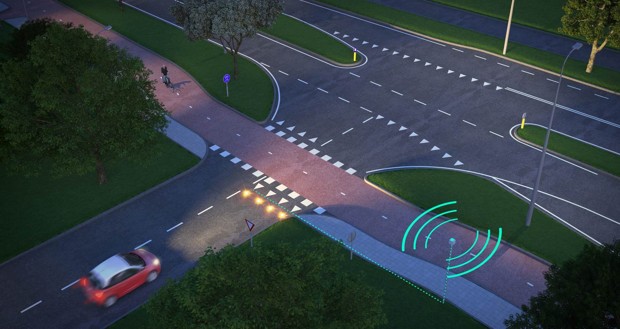
BikeScout is on the expensive side: installing the system in Eindhoven cost about $43,000, and upkeep will be another $1,100 each year, Fast Company reports. But the city believes it’s worth it: local traffic control can monitor the effects of BikeScout through an app, and the technology collects and stores data from the intersection, making it a useful tool for cities to consult when developing future infrastructure projects.
The Netherlands is a fairly safe country for cyclists, Joziene van de Linde, the managing director of technology at Heijmans, told Fast Company—but still, 25 percent of people who die in collisions there are on a bike. There’s a definite need, van de Linde said, to improve safety at intersections, especially because a spike in electric bike usage in the Netherlands has broadened the possible range of cyclist speeds. “Not all drivers are aware of those differences," she added.
But BikeScout will likely have an even greater impact in countries less used to sharing the road with cyclists than the Netherlands. Rik Hammer, the communications manager for Heijmans, tells CityLab that they’re looking to bring the technology to other cities. “Nobody intentionally goes on the road and says, ‘Let’s hit a cyclist today,’” van de Linde added. But drivers everywhere could use the additional reminder to slow down and pay attention.
A new digital stage for The Sydney Opera House
The Google Cultural Institute provides a new digital home for the Sydney Opera House, bringing together more than 1,000 artifacts and 60 years of history in a single online platform. From architect Jørn Utzon’s early designs, to the inner workings of the world’s biggest mechanical organ, to spectacular late night shows, these 50 online exhibits capture the Sydney Opera House from every angle.
“The Story Begins Here” exhibit explores the history of the building, the performances and events that have taken place on Bennelong Point.
This new collection showcases the variety of culture on offer at one of the world’s busiest performing arts centers, and brings many treasures out of the archives and into the spotlight for people to appreciate. Some of the rare content includes photographs of the opening with Queen Elizabeth II in 1973, roof design sketches from master builder and lead engineer Ove Arup, the diaries of architect Peter Hall, and Utzon's personal collection of photographs from the project, spanning nearly a decade.
The sculptural elegance of the Opera House has made it one of the most recognizable buildings of the 20th century. In addition to exhibits which tell the stories of the history and development of this architectural masterpiece, today’s launch includes a brand new 360° experience offering insights into the between-the-acts magic of the House. Starting at dawn beneath the sails, you can continue on to enjoy incidental performances by Soprano Nicole Car and the Sydney Symphony Orchestra, and then journey to many seldom seen areas of the House.
With new Street View imagery, you can virtually wander in and around the Opera House at your own pace, taking in stunning views from all angles. Gaze at the white sails overlooking Sydney’s picturesque harbor, feel what it’s like to stand on the Joan Sutherland Theatre stage and look up at the acoustic clouds of the Concert Hall.
The new collection opens today at g.co/sydneyoperahouse on the Google Cultural Institute website and is available for anyone on mobile phones, tablets and desktop computers. You can also view it via the new Google Arts & Culture mobile app from your iOS or Android device. We hope you enjoy experiencing the past, present and future of this World Heritage masterpiece.
Posted by Kate Lauterbach, Program Manager, Google Cultural Institute https://4.bp.blogspot.com/-TnmEizYVMP4/VyAIxNRpBcI/AAAAAAAASPA/8yZNyjpTQgghp7DVngmJLS9WlISJwzJxwCLcB/s1600/dusktodawn.png Kate Lauterbach Program Manager Google Cultural Institute
Your Dog Hates Hugs
I never met a dog I didn’t want to hug. The feeling, alas, is likely not mutual. In a giant bummer of an article published recently in Psychology Today, Stanley Coren — who studies canine behavior at the University of British Columbia — makes a sadly strong case against the...More »
Turns Out You Really Do Think Brilliant Thoughts in the Shower
The timeline of big moments in human history is littered with sudden, seemingly random realizations. Rene Descartes, for instance, came up with the idea for Cartesian geometry while watching a fly zoom around his bedroom. Paul McCartney wrote “Yesterday” after the fully formed tune plopped itself into his brain (“I...More »


